I. What is a Price?
|
money charged
for product or service |
sum of all values a
buyer exchanges for benefits of having/using product
or service |
From its narrowest definition to its broadest, price
has always been a major factor in buyer choice,
historically set by negotiation between buyer and seller
(dynamic pricing) with fixed pricing only a factor in the
last century or so. Things like the Internet and e-Bay are
seeing us returning to dynamic pricing.
And remember that Price and Profit are not
automatically "bad" words. A company must make a profit
in order to survive. There is an old Indian proverb,
told to me by the owner of The Herb House where I buy
many good things, that
asks, "If a horse makes a friendship with the grass,
what is he going to eat?" What is important is setting a
fair price.
2. Factors to Consider When
Setting Price
II. Major Pricing
Strategies
Customer Value-Based Pricing
This method involves setting the price
based on what the consumer thinks your product is worth
rather than on what it cost you to produce and sell it. At its worst, this concept
includes the time-worn phrase spoken whenever a marketer asks
how much s/he should charge for their product:
"Whatever the market will bear." Today, smart
marketers know that Value-Based Pricing has a lot more to
do with finding out what the customer values (see
Peter
Drucker's Third Question) and it means a lot of work
on the company's part in finding out just exactly what its
customers DO want.
I heard Jack Welch, retired Chair of
General Electric speak at the conference
on Emerging
Issues in Business and Technology, and he said
essentially what he's quoted as saying in your
textbook:
| "The
value decade is upon us. If you can't sell a
top-quality product at the world's best price,
you're going to be out of the game." |
Companies do this through
value pricing strategies, offering just the right
combination of price and quality to satisfy the customer;
an important part of this is
everyday low pricing (EDLP), where the company (Wal-Mart
is the best-known user of this method) keeps prices
consistently low with few discounts or temporary price
promotions. The strategy is supposed to encourage more
one-stop shopping, so that even though some prices on some
items may actually be higher than in other places, overall
the consumer feels s/he is getting a good
deal.
 |
Exercise:
Lab
Wal-Mart |
Go
shopping in a Wal-Mart. Make a note of some of their
prices on a product that interests you. Check other
stores and compare prices. Is Wal-Mart always the lowest
priced?
Post your answer in the
Moodle Discussion Group. |
|
There is also Good
Value Pricing, and Value-Added Pricing
Cost-Based Pricing
Types
of Costs
Cost-Plus Pricing
This involves adding a standard mark-up to the
cost of the product; it is simple to use and insures costs are covered, but has no
relationship to what consumers are prepared to pay for the
product
|
A major problem with this
technique is that the margin can vary greatly. In
the frozen food market, it can be anywhere from
13% to 53%. |
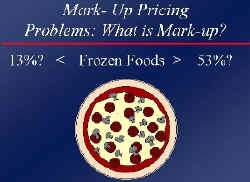
|
|
A
retail store adds a standard markup to the cost of products it
sells. For example, the retail store buys a hair dryer for $15
dollars from a manufacturer, adds $10 dollars to cover its own
costs and profits, and sells the hair dryer for $25.
|
 |
Exercise
Markup
and Margin |
What is the retail store's
markup?
What is the retail store's margin?
Post your answer in the
Moodle Discussion Group.
If you had difficulty with
calculating any of these, ask for help on the Discussion Group
or check the Appendix at the back of your book
|
|
Partial Cost
Recovery Sometimes
you know from the start that what you charge the
customer will not cover full costs. Why would
anyone in their right mind charge this kind of
price? Read the exercise below and think about it. |
 |
 |
Exercise
Partial Cost Recovery |
How is York University
tuition an example of "partial cost
recovery" pricing? Why does York only charge you
part of the cost of your education?
Post your answer in the
Moodle Discussion Group. |
|
Break-Even Pricing
(Also known as target profit pricing)
This
involves setting a price to break even on the costs of making
and marketing a product, or setting a price to make a
particular profit that you have in mind (target profit)
 |
Exercise
Break-Even |
One of
the best ways to learn and understand key concepts in
this or any course is to try to put them into plain
ordinary language.
In common ordinary
English words, explain why the difference between the
selling price and the variable cost is divided INTO the
amount of fixed costs.
Post your answer in the
Moodle Discussion Group.
|
|
Competition-Based
Pricing
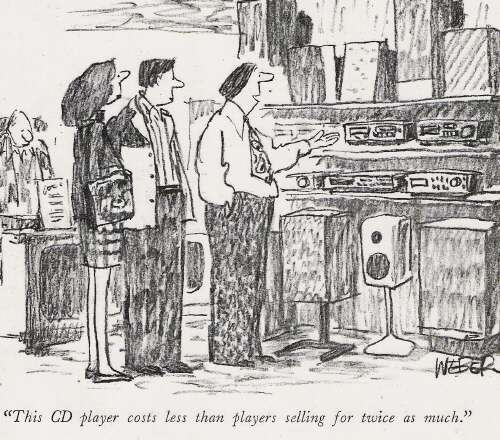 |
This cartoon makes
fun of what is actually a very serious business -
knowing what your competitor is charging and
understanding how to price with respect to that is
one of the toughest decisions made in
Marketing. |
III. Other Internal and External
Considerations Affecting Pricing Decisions
Internal
Factors Affecting Pricing Decisions
Marketing
Strategy
Who are you as a company? What is important to upper management?
 |
Exercise:
Plan
Organization Issues |
What
overall company factors will influence your choice of
price in your Marketing Plan product? (e.g.: is your company an old firm upholding a
reputation for quality, or is there something else
important about your company that will lead you to set a
particular kind of price?)
Post your answer in the
Moodle Discussion Group. |
|
Marketing Objectives - What does your
company want to do with this product?
Survival - if you're about to go under,
you price at whatever you think will bring in business
Current Profit Maximization - This is
risky, as you are first of all estimating both demand and
costs functions which gives you a figure that is to a
large extent guess-work, but also because it encourages
managers to think only in the short term
Market Share Leadership
When what you
ultimately want is a higher market share than any of your
competitors |
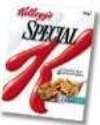 |
Product Quality
Leadership
When you're the first name
they think of when they want a trusted product |
 |
Marketing Mix
All the elements of the Marketing Mix have to work
together in a common strategy.
Even if we consider only variations in Price and Product
Quality,
there are nine major possible strategies
 |
Exercise:
Lab
Price/Quality |
Go on a shopping trip or
watch some television*. Find
an example of a Premium Value Strategy and an example of an
Economy Strategy; these should be fairly easy - more difficult: find an
example of Rip-Off Strategy or a False Economy Strategy.
Post your answer in the
Moodle Discussion Group.
|
|
| * I am probably one of very few
professors who will tell you that if you want to
succeed in this course you'll need to go shopping
more often and watch more television. |
External Factors
Affecting Pricing Decisions
The Market and Demand
Pricing in Different
Types of Markets
 |
Exercise:
Plan
Types of Markets |
Which kind of
market are you entering with your Marketing Plan
product?
Post your answer in the
Moodle Discussion Group.
|
|
Consumer Perceptions
of Price and Value (Demand and Supply)
 |
Exercise
Perception of Price |
Is there
something you have bought for which you paid much more
than it actually might be seen to be worth in the
market?
Post your answer in the
Moodle Discussion Group. |
|
Analyzing the
Price-Demand Relationship/Price Elasticity of Demand
|
Demand
Type |
What
Happens |
Occurs
When |
Pricing
Strategy Recommended |
|
Elastic |
percentage
change in price causes a much higher percentage
change in demand |
products
have many substitutes and
consumption is discretionary |
Lower
price to sell more |
|
Inelastic |
percentage
change in price causes a much smaller percentage
change in demand |
products
have few if any substitutes and
consumption is necessary |
Raise
prices to earn more profits |
 |
Exercise
Elasticity |
Give an example of a product
with elastic demand
and of one with relatively inelastic demand.
Post your answer in the
Moodle Discussion Group.
|
|
The Economy
These include "Ethical Considerations" and
"Legal and Regulatory Factors"
IV. New-Product Pricing
Market-Penetration Pricing
 |
Exercise
- Plan
Skimming/Penetration |
Which
will be most appropriate for your Marketing Plan
product? Why?
Post your answer in the
Moodle Discussion Group. |
|
Note that Market Penetration Pricing is
not the same thing as
| Introductory
Price Dealing - such as a special cents off
coupon for cookies made to
compete with Oreos (they weren't successful)
|

|
V. Product Mix Pricing
Product Line Pricing
Optional-Product,
Captive-Product, By-Product, and Product-Bundling Pricing
For more about weddings and Marketing,
check out an exercise in the Consumer
Behaviour course, AK/ADMS3210 3.0.
VI. Price-Adjustment
Strategies
Discount and
Allowance Pricing
 |
Exercise
- Plan
Customer Adjustment |
Which of
these discounts or allowances can you make in marketing
your Marketing Plan product? Describe any relevant ones
and how they will work for your product.
Post your answer in the
Moodle Discussion Group. |
|
Segmented Pricing
Psychological
Pricing
Retailers often set prices to make us
feel we are getting a better deal than we really
are. Deep discounts can be a real psychological lure.
I have bought clothing I was 99% I would never wear
because the price was right (a $149 dress for $5 at
Winners).
What is a "high" price? Surely
it's mostly in the mind of the consumer. If you think gas
prices are high today, compare the cost per gallon to the
cost of some other fluids (these are in US terminology -
from an Internet article sent in by a student in this
class in a previous term)
| You Think
Gas is Expensive at $3 a Gallon? |
| Diet Snapple 16 oz
$1.29 ....... $10.32 per gallon |
| Lipton Ice Tea 16 oz
$1.19 ..... $9.52 per gallon |
| Gatorade 20 oz $1.59
..............$10.17 per gallon |
| Ocean Spray 16 oz
$1.25 ........$10.00 per gallon |
| Brake Fluid 12 oz
$3.15 ...........$33.60 per gallon |
| Vick's Nyquil 6 oz
$8.35 ...........$178.13 per gallon |
| Pepto Bismol 4 oz
$3.85 ..........$123.20 per gallon |
| Whiteout 7 oz $1.39
..................$25.42 per gallon |
| Scope 1.5 oz $0.99
..................$84.48 per gallon |
| Evian water 9 oz for
$1.49 .......$21.19 per gallon. |
| So,
the next time you're at the pump, be glad your car
doesn't run on water, or worse, Nyquil!
|
| Pricing can also be psychological from
the point of view of the retailer. In the spring of 2003
after the SARS outbreak, in order to bring tourists back
to Toronto, Ed Mirvish (owner of Honest Ed's and the
theatres at which Mama Mia and The Lion King
were playing) got together with local hotels and the Blue
Jays and offered a package deal for $125, which included a
night in a luxury hotel, tickets to one of the two
musicals, and tickets to a Blue Jays game. He was quoted
in the Globe and Mail as saying that while no
retailer likes to lower prices, "by putting it in a
package, none of us feel our product is being
discounted."
This leads us right into
Promotional Pricing. |
 |
 |
Exercise
Special Pricing |
After the SARS health
outbreak in Toronto, all kinds of retailers and entertainers
offered discounts to try to get Toronto back on its feet. What
other examples can you cite of special discounting, special
packaging of events of which you have personal knowledge, maybe
even something you went to?
Post your answer in the
Moodle Discussion Group.
|
|
Promotional Pricing
Geographical Pricing Pricing
products for customers located in different parts of the
country
Dynamic Pricing We're
seeing much more of this traditional method of pricing
(think Bartering) as companies increase their sales on the
Internet
International Pricing Pricing
products for customers in different countries depending on
local conditions
VII. Price Changes
Initiating Price
Changes
Responding to
Price Changes
 |
Exercise
- Plan
Meeting
the Competition |
What is
your strongest competitor in your Marketing Plan doing
about pricing? How will that affect your pricing
policy?
Post your answer in the
Moodle Discussion Group. |
|
VIII. Public Policy and
Pricing
Some things aren't
considered nice to do in competition, some things are
downright illegal, and some things that sound off-kilter
are okay if done under the right circumstances.
There are laws against price fixing and
predatory pricing (at channel level) and against retail
price maintenance, discriminatory pricing, and deceptive
pricing (across channel levels).
| Outright deceptive
pricing is illegal: |
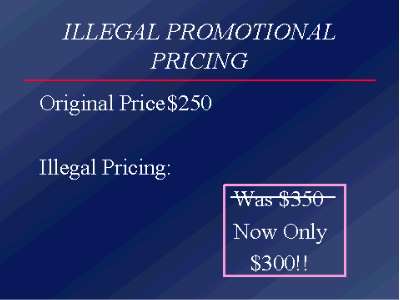 |
| But some forms of
price discrimination are legal, for example this
price discrimination based on product form: |
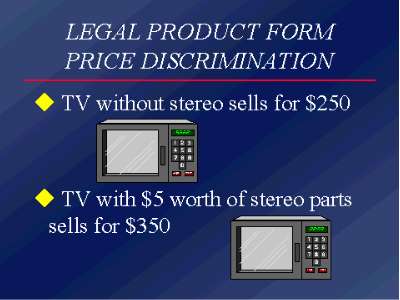 |
Even though the stereo parts only cost $5.00, the
inclusion of them into the TV to make a different product
(TV with stereo) legally justifies charging a higher price
for the finished item (whether is fair to consumers is an
issue to be dealt with in considerations of ethics, and in
the market - will consumers buy the higher priced
product?
Compliance with the law ought to be the minimum standard but it
rarely is. There are numerous example all around us of unfair
pricing, of prices that are far too high, that disadvantage some
groups of people, that prey on those in need, that take advantage
of some people.
 |
Exercise:
Lab
Unethical Pricing |
Can you find some examples of
unfair pricing in that great big Marketing Laboratory out there in
the shops and stores in the city where you live? Or on the
Internet if it's too hot or too cold or too wet or you're too busy
to go out?
Post your
answer in the
Moodle Discussion Group.
|
|
Pricing in the "Real"
World - Stewart McLean on Earmuffs
From a Stewart MacLean radio talk (with Peter Gzowski)
about earmuffs. It had
recently come back into fashion, and a lot of the reason
had to do with five of the most important elements of
Marketing, including pricing.
5 Important Elements
of Successful Marketing
Hard Work
Including R&D and Product
Development
"Just like the Marketing Professors tell you"
the producer adds, the company was doing research on their
product |
 |
Dumb Luck
Being in the right
place at the right time: a European model visiting New
York saw the earmuffs in a store and liked them; her
husband worked in Marketing |
 |
Creative Thinking
How to make something very
old-fashioned into a "new" fashion |
 |
Clever Packaging
They put the ear muffs in a box that looked like
a hamburger container and called it the McMuff (didn't get
sued by McD's as far as I know) |
 |
Right Pricing
Price it under $10 and put it in a
box and you've got an instant present |
 |
|